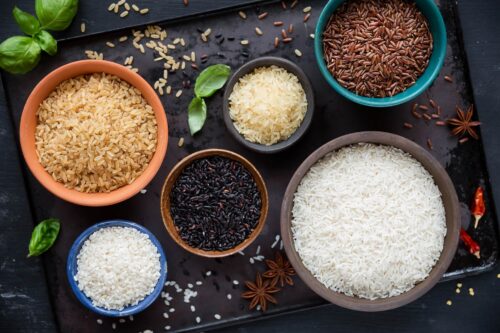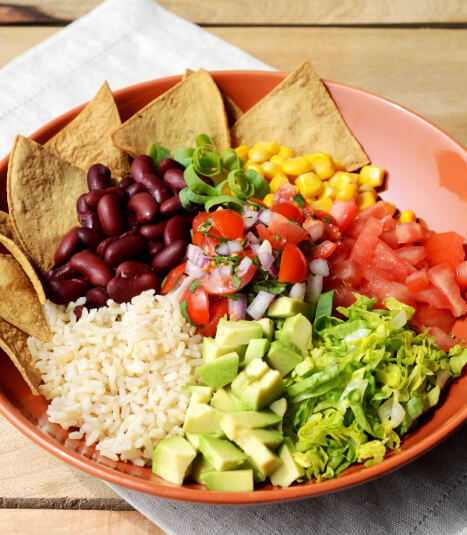For the Love of Grains
Cereal grains are currently the most important nutritional component of the human diet—and for thousands of years grains have been recognized as staples—necessary foods—and extolled as ‘the staff of life.’ In Roman times Ceres was the goddess of agriculture.1 The gifts offered to Ceres at festivals were referred to as cerealia. Since the most important gifts offered were wheat and barley, these grains naturally became known as cerealia or cereal. The value of grains is reflected by common sayings such as: ‘The greatest thing since sliced bread,’ signifying the absolute best, ‘bread and circuses’ refers to keeping people happy, ‘cash’ is called bread or dough, and ‘breaking bread’ speaks of a sense of sharing.
It may surprise you to learn that after this long association of grains with goodness that this staple food is now under attack. I hear:
1) Don’t eat rice and other grains because they turn to sugar, which will make you fat. Even the tiniest bite of a grain will trigger your body to crave more and you will become obese. After all, grains are used for fattening livestock, and they will do the same to you.
2) If you don’t soak your grains before cooking, they will ‘steal’ nutrients from your body—this is due to phytic acid and other anti-nutrients in the grains.
3) Millions of people are intolerant to the protein in grains, causing problems from arthritis to cancer, for most people, not just those few with celiac disease.
4) Grains harbor toxic fungi that can cause cancer.
5) Grains have drug-like substances in them that create addiction. If you eat them, you will become hooked on grains.
Separating the wheat from the chaff—fact from fiction—begins by knowing that cereal grains provide an abundance of our most important nutrient: starch—70% to 83% of the calories found in grains are in the form of this clean burning carbohydrate fuel.
|
Grains are the seeds of grasses. Globally, the most important cereal grains include wheat, rice, and corn, whereas the minor grains include oats, rye, barley, triticale, sorghum, and millet. Triticale is a hybrid between rye and wheat. Wheat accounts for one-third of the total worldwide grain production and rice accounts for one-fourth. In order to bring out their nutrition and flavor, grains are almost always consumed after cooking and/or grinding (milling). Rice and sorghum are grown in warm climates; whereas wheat, rye, triticale, oats, barley, and spelt are grown in colder seasonal, temperate regions. Amaranth, quinoa, and buckwheat are pseudocereals derived from broadleaf plants, not grasses, however, they are used much like cereal grains. Starch is a ‘complex carbohydrate’ made up of long chains of sugar molecules, stored in the plant’s parts for the future. This stockpile is used for survival overwinter, to regrow the next year, and to reproduce. In the case of grains, the starch stored in the seedling provides the energy for the first few hours of life, before the leaves begin their own photosynthesis. Starchy plant food-parts, are simply called ‘starches.’ Tubers (potatoes, sweet potato, cassava), winter squashes, legumes (beans), and grains serve as organs for storing starch. In contrast, green and yellow vegetables, such as broccoli, cauliflower, and asparagus, accumulate relatively little starch, and fruit sugars are simple sugars, not starch. |
People Are Obligate Starch-Eaters
For the past 35 years I have been teaching a ‘starch-based diet’ as the fundamental means to health and healing. This is different from a ‘vegan diet,’ which could be at its worst, colas and potato chips; and different from a ‘plant-food-based diet,’ which could focus on low-calorie broccoli and apples, or high-calorie nuts and avocados. Most people—lay and professional—fail to grasp this simple lifesaving premise: people are starch-eaters. And they suffer horribly from this unawareness.
The most important support for my conclusion that we are starch-eaters is based on an observation that you can easily validate for yourself: All large populations of trim, healthy people, throughout written human history, have obtained the bulk of their calories from starch. Examples of thriving people include, Japanese and Chinese in Asia eating sweet potatoes, buckwheat, and/or rice, Incas in South America eating potatoes, Mayans and Aztecs in Central America eating corn, and Egyptians in the Middle East eating wheat.
There have been small communities of people living at the extremes of the environment, such as the traditional Eskimos of Greenland, who have lived on a diet low in starches (high in meat). Over the past century there has been an escalating trend in Western societies of people abandoning starchy plant-foods for low-carbohydrate meat and dairy foods. A worldwide epidemic of obesity, heart disease, diabetes, and cancer has followed this dietary change. Thus, there are no exceptions—all large populations of healthy, trim people have lived on starch-based diets. We are obliged to eat starch, and failure to eat this way, means failure to thrive—both as individuals and as civilizations.
|
Historical Examples of Grain-Based, Starch-Based, Diets Barley – Middle East for 11,000 years Corn – Central and South America for 7000 years Millet – Africa for 6,000 years Oats – Middle East for 11,000 years Sorghum – East Africa for 6,000 years Rice – Asia for more than 10,000 years Rye – Asia for 5000 years Wheat – Near East for 10,000 years |
 |
DNA Science Proves Starch-Based Diet for People
Through genetic testing scientists have proven that we are obligate starch-eaters.2 Examination of the number of copies of the gene for the production of amylase, an enzyme in our saliva that digests starch, has found an average of 6 copies in humans (range of 2 to 15 copies), compared to only 2 copies of this gene in great apes. This amplified number of gene copies allowed early humans to thrive on starchy foods that ‘lesser’ primates ignored. The diets of great apes, like those of chimpanzees, our closest relative, are nearly pure vegetarian in composition; consisting largely of fruits, and in the dry seasons when fruit is scarce, they eat tree seeds, flowers, soft pith, and bark; with termites and small mammals making a very small contribution all year long. Chimpanzees eat very little starch.
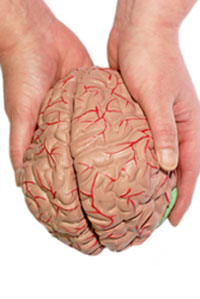 Human and chimp DNA is roughly 99% identical, but that 1% difference, which includes genes to digest much more starch, proved crucial for the evolution of humanity’s earliest ancestors. More salivary, starch-digesting, amylase produced by more copies of the gene opened up a reliable supply of sugar for our early ancestors, which allowed their sugar-fueled brains to develop. Twenty percent of our daily food intake is used to energize our brains; and brain tissues preferentially burn sugar for fuel. The theory that the addition of meat or fish to our ancestor’s diet was the critical factor for the development of our ancestors’ brains is obviously incorrect based on our physiology and genetics.3-5 Furthermore, since most early humans ate meat only sporadically, meat alone could not have supplied the extraordinary amount of energy needed for the brain to grow from monkey-size to human-size (three times difference).3-5
Human and chimp DNA is roughly 99% identical, but that 1% difference, which includes genes to digest much more starch, proved crucial for the evolution of humanity’s earliest ancestors. More salivary, starch-digesting, amylase produced by more copies of the gene opened up a reliable supply of sugar for our early ancestors, which allowed their sugar-fueled brains to develop. Twenty percent of our daily food intake is used to energize our brains; and brain tissues preferentially burn sugar for fuel. The theory that the addition of meat or fish to our ancestor’s diet was the critical factor for the development of our ancestors’ brains is obviously incorrect based on our physiology and genetics.3-5 Furthermore, since most early humans ate meat only sporadically, meat alone could not have supplied the extraordinary amount of energy needed for the brain to grow from monkey-size to human-size (three times difference).3-5
Apparent Imperfections of Grains
No single food is always perfect for every person: Beans may be a little too high in protein, especially for people with inadequate kidneys, white potatoes are classified as nightshades that can contain a toxin called solanine, winter squashes may be too low in calories for athletes, corn may cause food allergies in sensitive people, and wheat has gluten which causes celiac disease in a few people. Recently, several writers, who by no coincidence also recommend diets high in meat, fish and/or dairy products, have misled the public by stretching the truth—overstating the importance of the imperfections and minimizing the benefits of grains.6-8 Some of their claims are:
Grains Will Make You Fat—Not So!
Really: Obesity is unknown among more than 3 billion people who currently live on grain-based diets and the billions more who have done so in the past. Grains are low in calories, low in fat, and high in appetite-satisfying carbohydrates. While overfeeding with grains can easily fatten food-animals, like cows and pigs; the human body only reluctantly converts carbohydrates, like those found in grains, into body fat.9
Grains Rob You of Nutrients—Not Important
Really: Grains are loaded with minerals; therefore, the more grains you eat the more minerals you consume. Phytic acid, also plentiful in grains, is considered an anti-nutrient because of its ability to bind with minerals, such as zinc and calcium, and prevent their absorption. Two often-cited examples of zinc deficiency are among people living in small communities in rural Iran and Australia (Aborigines).10-11 Multiple nutritional factors, not just phytic acid, were involved in both examples. Consumption of large amounts of unleavened bread seemed central to the development of zinc deficiency. Once the bread is leavened, then the activity of phytic acid is reduced, and zinc becomes readily available.12 Soaking, germination, boiling, cooking, and fermentation all inactivate phytic acid and free up minerals for absorption. In real-life situations, for otherwise healthy people, the consumption of grains in recommended amounts has had no adverse effect on mineral status.13
Phytic acid actually has many beneficial health effects—you won’t want it out of your diet. It acts as a powerful antioxidant and has been shown to reduce blood sugar, insulin, cholesterol and triglycerides.14 Phytic acid is linked to a reduction in heart disease, diabetes, obesity, and other chronic diseases in people.13,14
Grains Cause Human Disease—Some Do
Really: Some people (at most 1% of people) are intolerant of a protein, called gluten, found in some grains. High concentrations of gluten are found in wheat, barley, and rye (but not in rice, corn, oats, sorghum, and millet). (See my September 2005 newsletter article.) The condition, called celiac disease, can result in malnutrition, autoimmune diseases and cancer.
Grains are slightly acidic; therefore, theoretically, they may cause loss of minerals, including calcium, from the body. (The relative acid load of grains is about +1, compared to the very high acid loads of cheese +10, fish +9.3, chicken +7 and red meat +6.3).15 Limited research shows grains do not increase calcium loss,16 and grain-consuming populations, such as the Japanese and Chinese, have very low rates of osteoporosis.17,18
Food allergies to wheat and corn do occur in less than 1% of people, but allergies to rice are very uncommon;19 this is one reason rice is an accepted food in elimination diets designed to test and treat food allergies.
Fungi on Grains Will Poison You—So Don’t Eat Spoiled Food
Really: Aflatoxins are naturally occurring toxins that are produced by many species of toxins. The toxin-producing fungi grow as the grains spoil in storage. Aflatoxins are toxic and carcinogenic. High-levels of aflatoxin exposure can produce acute tissue necrosis, cirrhosis, and carcinoma of the liver. This potential and serious problem should cause us to avoid spoiled grains. Boiling and pressure-cooking reduce the activity of this toxin.20, 21
You Will Become Addicted to Grains—Yes!
Really: Just like you have become addicted to water and the oxygen in air. The human body is designed to enjoy and become satiated by carbohydrate—both simple and complex sugars (starches)—not surprising since this substance is our intended fuel. Consider the tips of our tongues have sweet-tasting taste buds. We are designed to seek and enjoy this flavor. There are no similar sensors on our tongues for fat or protein. (A cat has taste buds for protein.) Once consumed, carbohydrate causes changes in bodily hormones and brain chemistry, resulting in satisfaction of the appetite—our reward for eating correctly. Failure to eat sufficient carbohydrate, when people consume beef, chicken, fish and cheese, all containing almost no carbohydrate, leaves them wanting sugars, which may cause some people to conclude that they are addicted to carbohydrate.
Top Nutrition in Grains
Grains are derived from the seeds of grasses. They contain all the energy (starch), protein, and minerals needed to germinate a seedling, therefore they are inherently nutritious. Grains contain no cholesterol, are low in fat, and are high in dietary fiber. Although grains are low in fat they are well supplied with the few kinds of fat (linolenic and linoleic acid) that are essential for our health. The ingredients in single grains easily meet our nutritional needs, except for vitamins A and C. Thus, people cannot live on grains alone; they must also include a fruit and/or a green or yellow vegetable to supply these two essential vitamins. (In contrast, vegetables, like potatoes and sweet potatoes supply all necessary nutrients and can serve as sole sources of food. Qualified exceptions to this statement of completeness are vitamins B12 and D – see my September and November 2007 McDougall Newsletters.)
|
Established Benefits of Eating Whole Grains Lowers Cholesterol Lowers Blood Sugar Lowers Insulin Levels Lowers IGF-1 Levels Reduces Risk of Thrombosis Reduces Heart Attack Risk Reduces Risk of Type-2 Diabetes Reduces Risk of Obesity Reduces Insulin Resistance Lowers Colon Cancer Risk Lowers Gastric Cancer Risk Improves Bowel Function Accelerates Bowel Transit Time Delays Gastric Emptying Relieves Constipation Increases ‘Good’ Bowel Bacteria (bifidobacteria) Decreases ‘Bad’ Bowel Bacteria (E. Coli) Provides Anti-oxidant Activity Thousands of scientific studies confirm the healthful benefits of whole grains. (Unfortunately, most of this research has been funded by the cereal industries.22) |
Can I Eat Flour Products, Like in Bread?
Although cereal grains at the farm gate are very nutritious, the processing and refining steps that follow usually turn them into packaged products that are now stripped of their nutrients (fiber, vitamins, and minerals) and loaded with salt, oils, sugars, dairy- derivitives, and chemicals. Whereas, whole grains reduce the risk of heart disease, diabetes, cancer and obesity, that box of sugar puffs in your pantry may be doing just the opposite. In general, the more original and unadulterated the grain, the better for you.
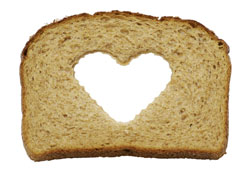
I am often asked if there is any harm in using a home-bread-machine to make bread—after all, nothing is added or removed in the processing. For most people whole grain breads are an excellent choice, but it is not the same as eating whole grains. Beating the whole grain more than 1000 times with the whirling steel blade of the bread machine converts the kernel into a powder, known as flour. The intact cell wall of the kernel has been destroyed and now the digestive enzymes (amylase) easily digest the inner nutrients. In addition, the flour has a much larger surface area to volume ratio than did the whole grain, making digestion and absorption much more rapid. For you this physical change may translate into easier weight gain, and higher blood levels of glucose, triglycerides, and cholesterol. The amount of insulin released by the pancreas into the blood is also increased as grains are processed from whole grains to cracked grains to coarse flour to fine flour.23 More insulin can mean more weight gain, and maybe, more risk of diabetes and heart disease. However, compared to animal-foods, free-oils, and plant-parts processed beyond recognition, whole wheat bread is definitely health food.
Can I Eat White Rice?
If you must. As a young doctor, I began my practice in Hawaii. Ancestors of many of my patients had recently emigrated from countries, like Japan, China, and the Philippines, where rice was their staple food. That is white rice. In these cultures, eating brown, whole grain, rice was a social disgrace; because it was cheaper, brown rice was consumed by the lower class, financially poorer, people. Thus, a social prejudice existed: refined people eat refined rice. I could not overcome this irrational bias, so I sanctioned eating the McDougall diet with white rice—and my patients still became healthier, lost weight, and stopped their medications. Why? Because white rice replaced their meat, cheese, and ice cream. One of the most successful diet therapies ever used to treat sick people has been the Kempner Diet from Duke University. The founder, Walter Kempner, MD, fed his patients mostly white rice and fruits. This treatment quickly and effectively reversed hypertension, type-2 diabetes, diabetic eye damage, arthritis, heart failure (cardiomegaly and EKG changes), kidney disease, and obesity.24
Think Simple. Think Starch.
The two most important dietary messages I want you to learn are:
1) Health and personal appearance change dramatically by simply changing the composition of the foods consumed. When cheeseburgers, pork chops, chicken wings, and cheese are the daily fare, then people are fat and sick. Filling the dinner plate with whole grains, legumes, tubers, green and yellow vegetables, and fruit results in robust health. Don’t complicate matters by focusing on secondary issues, like heredity, exercise, stress, etc.
2) Starches, not green and yellow vegetables and fruits, must make up the bulk of the meals for satisfaction and proper nutrition. Grains are an excellent source of starch.
References:
1) http://books.google.com/books?id=Mbk2AAAAMAAJ&lpg=PA3&dg=corn+importance+ancient&source=web&ots
=tSzrBIObXn&sig=9P9GOgJ3NXIFj_kuARpzCpjXWEE#PPA12,M1
2) Perry GH, Dominy NJ, Claw KG, Lee AS, Fiegler H, Redon R, Werner J, Villanea FA, Mountain JL, Misra R, Carter NP, Lee C, Stone AC (2007). Diet and the evolution of human amylase gene copy number variation. Nature Genetics 39: 1256-1260.
3) Langdon JH. Has an aquatic diet been necessary for hominin brain evolution and functional development? Br J Nutr. 2006 Jul;96(1):7-17.
4) Carlson BA, Kingston JD. Docosahexaenoic acid, the aquatic diet, and hominin encephalization: difficulties in establishing evolutionary links. Am J Hum Biol. 2007 Jan-Feb;19(1):132-41.
5) Carlson BA, Kingston JD. Docosahexaenoic acid biosynthesis and dietary contingency: Encephalization without aquatic constraint. Am J Hum Biol. 2007 Jul-Aug;19(4):585-8.
6) Loren Cordain, PhD. http://www.thepaleodiet.com/
7) Joseph Mercola, DO. http://www.mercola.com/
8) Melissa Diane Smith: http://www.melissadianesmith.com/
9) Hellerstein MK. De novo lipogenesis in humans: metabolic and regulatory aspects. Eur J Clin Nutr. 1999 Apr;53 Suppl 1:S53-65.
10) Reinhold JG. High phytate content of rural Iranian bread: a possible cause of human zinc deficiency. Am J Clin Nutr. 1971 Oct;24(10):1204-6.
11) Cheek DB, Smith RM, Spargo RM, Francis N. Zinc, copper and environmental factors in the aboriginal peoples of the North West. Aust N Z J Med. 1981 Oct;11(5):508-12
12) Reinhold JG, Parsa A, Karimian N, Hammick JW, Ismail-Beigi F. Availability of zinc in leavened and unleavened wholemeal wheaten breads as measured by solubility and uptake by rat intestine in vitro. J Nutr. 1974 Aug;104(8):976-82.
13) Slavin JL, Martini MC, Jacobs DR Jr, Marquart L. Plausible mechanisms for the protectiveness of whole grains. Am J Clin Nutr. 1999 Sep;70(3 Suppl):459S-463S. Review.
14) Slavin J. Why whole grains are protective: biological mechanisms. Proc Nutr Soc. 2003 Feb;62(1):129-34.
15) Remer T. Potential renal acid load of foods and its influence on urine pH. J Am Diet Assoc. 1995 Jul;95(7):791-7.
16) Spencer H, Norris C, Derler J, Osis D. Effect of oat bran muffins on calcium absorption and calcium, phosphorus, magnesium and zinc balance in men. J Nutr. 1991 Dec;121(12):1976-83.
17) Abelow B. Cross-cultural association between dietary animal protein and hip fracture: a hypothesis. Calcific Tissue Int 50:14-8, 1992.
18) Frassetto LA. Worldwide incidence of hip fracture in elderly women: relation to consumption of animal and vegetable foods. J Gerontol A Biol Sci Med Sci. 2000 Oct;55(10):M585-92.
19) Venter C, Pereira B, Grundy J, Clayton CB, Arshad SH, Dean T. Prevalence of sensitization reported and objectively assessed food hypersensitivity amongst six-year-old children: a population-based study. Pediatr Allergy Immunol. 2006 Aug;17(5):356-63.
20) Park JW, Lee C, Kim YB. Fate of aflatoxin B1 during the cooking of Korean polished rice. J Food Prot. 2005 Jul;68(7):1431-4.
21) Park JW, Kim YB. Effect of pressure cooking on aflatoxin B1 in rice. J Agric Food Chem. 2006 Mar 22;54(6):2431-5.
22) Kelly SA, Summerbell CD, Brynes A, Whittaker V, Frost G. Wholegrain cereals for coronary heart disease. Cochrane Database Syst Rev. 2007 Apr 18;(2):CD005051.
Recommended Articles
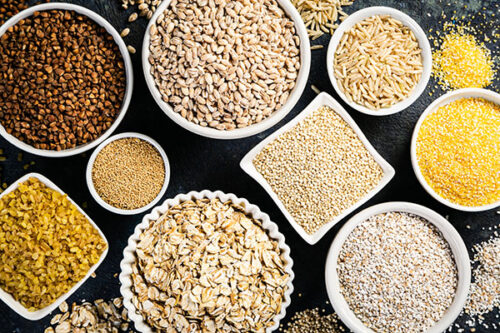
The Truth About Starch (Anti Wheat Belly & Grain Brain)
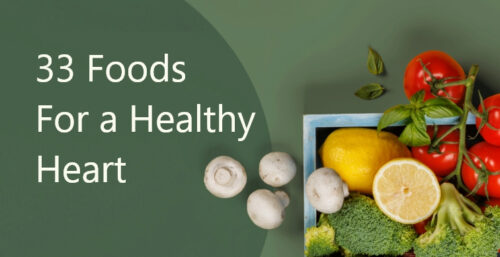
33 Foods For a Healthy Heart
